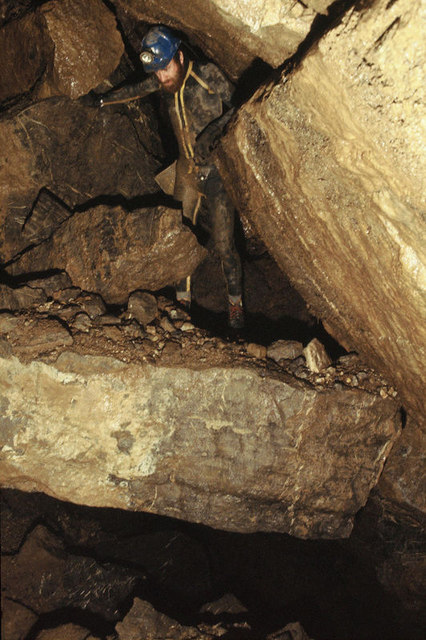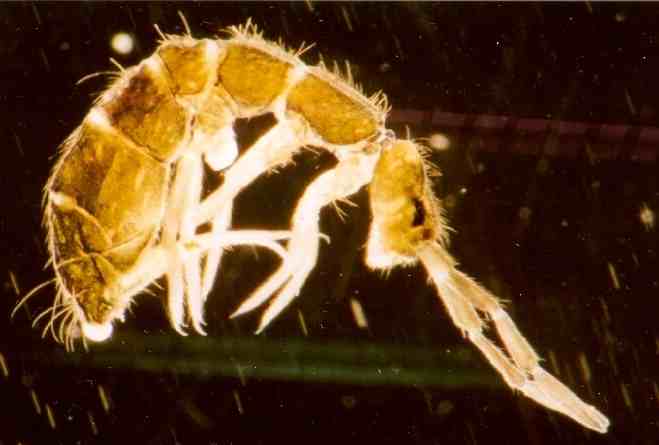|
St Cuthberts Swallet
St Cuthbert's Swallet is the second longest, and most complex, cave on the Mendip Hills, in Somerset, England. It forms a major part of the Priddy Caves system and water entering this Sinkhole, swallet re-emerges at Wookey Hole. – which also contains a detailed description of the cave. St Cuthbert's Swallet is part of, and lies underneath, the Priddy Pools Site of Special Scientific Interest. It is named because of its location in the St Cuthbert Out parish of Wells, Somerset, Wells, and was originally called St Cuthbert's Pot. History Interest in the possible existence of a cave at this location existed before 1927, and increased when St Cuthbert's Pool suddenly drained away in that year. Attempts to discover an entrance took place between 1944 and 1953, when entry was finally gained. Exploration continued to push the known limits of the cave throughout the 1950s and 1960s. sump (cave), Sump 1 was passed in 1969. Sump 2 has not yet been passed. Access Due to a still ... [...More Info...] [...Related Items...] OR: [Wikipedia] [Google] [Baidu] |
Priddy
Priddy is a village in Somerset, England in the Mendip Hills, close to East Harptree and north-west of Wells, Somerset, Wells. The village lies in a small hollow near the summit of the Mendip range of hills, at an elevation of above sea-level, and has evidence of occupation since Neolithic times. There are remains of lead mining activities and caves in the limestone beneath the village. It is the venue for the annual Priddy Folk Festival. The Sheep Fair, was last held in 2013. Etymology It is generally agreed among toponymic specialists that the first element of Priddy is most likely to be a British (ie pre-English) word, ''pridd'', and various forms thereof, with a general sense of 'mud, earth, clay, soil'. Despite many claims to the contrary, the second element of the toponym is ''entirely'' unknown, despite attempts to resolve it - this is in large measure due to the lack of reliable early spellings. Albert Thompson's meticulous deconstruction of the landscape archaeolo ... [...More Info...] [...Related Items...] OR: [Wikipedia] [Google] [Baidu] |
Phreatic
''Phreatic'' is a term used in hydrology to refer to aquifers, in speleology to refer to cave passages, and in volcanology to refer to a type of volcanic eruption. Hydrology The term phreatic (the word originates from the Greek , meaning "well" or "spring") is used in hydrology and the earth sciences to refer to matters relating to groundwater (an aquifer) below the water table. The term 'phreatic surface' indicates the location where the pore water pressure is under atmospheric conditions (i.e., the pressure head is zero). This surface usually coincides with the water table. The slope of the phreatic surface is assumed to indicate the direction of groundwater movement in an unconfined aquifer. The phreatic zone, below the phreatic surface where rock and soil are saturated with water, is the counterpart of the vadose zone, or unsaturated zone, above. Unconfined aquifers are also called phreatic aquifers because the phreatic surface provides their upper boundary. Speleolog ... [...More Info...] [...Related Items...] OR: [Wikipedia] [Google] [Baidu] |
Troglobite
A troglobite (or, formally, troglobiont) is an animal species, or population of a species, strictly bound to underground habitats, such as caves. These are separate from species that mainly live in above-ground habitats but are also able to live underground (eutroglophiles), and species that are only cave visitors (subtroglophiles and trogloxenes). Land-dwelling troglobites may be referred to as troglofauna, while aquatic species may be called stygofauna, although for these animals the term ''stygobite'' is preferable. Troglobites typically have evolutionary adaptations to cave life. Examples of such adaptations include slow metabolism, reduced energy consumption, better food usage efficiency, decrease or loss of eyesight (anophthalmia), and depigmentation (absence of pigment in the integument). Conversely, as opposed to lost or reduced functions, many species have evolved elongated antenna (biology), antenna and leg, locomotory appendages, in order to better move around and respon ... [...More Info...] [...Related Items...] OR: [Wikipedia] [Google] [Baidu] |
Springtail
Springtails (class Collembola) form the largest of the three lineages of modern Hexapoda, hexapods that are no longer considered insects. Although the three lineages are sometimes grouped together in a class called Entognatha because they have internal Arthropod mouthparts, mouthparts, they do not appear to be any more closely related to one another than they are to insects, which have external mouthparts. Springtails are omnivorous, free-living organisms that prefer moist conditions. They do not directly engage in the decomposition of organic matter, but contribute to it indirectly through the fragmentation of organic matter and the control of soil microbial communities. The word ''Collembola'' is from Ancient Greek 'glue' and 'peg'; this name was given due to the existence of the collophore, which was previously thought to stick to surfaces to stabilize the creature. Early DNA sequence studies suggested that Collembola represent a separate Lineage (evolution), evolutionary ... [...More Info...] [...Related Items...] OR: [Wikipedia] [Google] [Baidu] |
Cave Insects
Cave-dwelling insects are among the most widespread and prominent troglofauna (cave-dwelling animals), including troglobites, troglophiles, and trogloxenes. As a category of ecological adaptations, such insects are significant in many senses, ecological, evolutionary, and physiological. Introduction A cave is an unusually well-defined ecological habitat in terms of its nature, time, and place. Accordingly, it is not surprising that a number of insects permanently inhabit caves, especially at the deepest levels, and are markedly specialised for niches in some of the extreme conditions. These are the true cavernicole species; troglobites rather than troglophiles or trogloxenes. These include; spiders and insects. Cavernicolous insect species rarely are adapted to move from cave to cave, so each species or community generally will be restricted wholly to certain caves or cave systems each, and commonly will have evolved in their respective home cave systems. Exceptions commonly are ... [...More Info...] [...Related Items...] OR: [Wikipedia] [Google] [Baidu] |
Crystals
A crystal or crystalline solid is a solid material whose constituents (such as atoms, molecules, or ions) are arranged in a highly ordered microscopic structure, forming a crystal lattice that extends in all directions. In addition, macroscopic single crystals are usually identifiable by their geometrical shape, consisting of flat faces with specific, characteristic orientations. The scientific study of crystals and crystal formation is known as crystallography. The process of crystal formation via mechanisms of crystal growth is called crystallization or solidification. The word ''crystal'' derives from the Ancient Greek word (), meaning both "ice" and " rock crystal", from (), "icy cold, frost". Examples of large crystals include snowflakes, diamonds, and table salt. Most inorganic solids are not crystals but polycrystals, i.e. many microscopic crystals fused together into a single solid. Polycrystals include most metals, rocks, ceramics, and ice. A third category of ... [...More Info...] [...Related Items...] OR: [Wikipedia] [Google] [Baidu] |
Fern
The ferns (Polypodiopsida or Polypodiophyta) are a group of vascular plants (plants with xylem and phloem) that reproduce via spores and have neither seeds nor flowers. They differ from mosses by being vascular, i.e., having specialized tissues that conduct water and nutrients, and in having life cycles in which the branched sporophyte is the dominant phase. Ferns have complex leaf, leaves called megaphylls that are more complex than the microphylls of clubmosses. Most ferns are leptosporangiate ferns. They produce coiled Fiddlehead fern, fiddleheads that uncoil and expand into fronds. The group includes about 10,560 known extant species. Ferns are defined here in the broad sense, being all of the Polypodiopsida, comprising both the leptosporangiate (Polypodiidae (plant), Polypodiidae) and eusporangiate ferns, the latter group including horsetails, Psilotaceae, whisk ferns, marattioid ferns, and ophioglossoid ferns. The fern crown group, consisting of the leptosporangiates and ... [...More Info...] [...Related Items...] OR: [Wikipedia] [Google] [Baidu] |
Cave Pearl
A cave pearl is a small, usually spherical, speleothem (cave formation) found in limestone caves. Cave pearls are formed by a concretion of calcium salts that form concentric layers around a nucleus. Exposure to moving water polishes the surface of cave pearls, making them glossy; if exposed to the air, cave pearls can degrade and appear rough. Composition A cave pearl is composed primarily of calcite (calcium carbonate aCO3. Cave pearls are generally not considered to be a type of oolite. Other minerals found in small quantities in cave pearls include quartz (silicon dioxide iO2, apatite (a group of phosphate minerals), iron, aluminium, and magnesium. Formation Cave pearls form when water dripping into a cave loses carbon dioxide and precipitates calcite. A cave pearl forms when the water is moving too vigorously to form a stalagmite. A nucleus of matter (such as a grain of sand) becomes coated with calcite, and the current then provides a rotation to the nucleus in suc ... [...More Info...] [...Related Items...] OR: [Wikipedia] [Google] [Baidu] |
Great Britain
Great Britain is an island in the North Atlantic Ocean off the north-west coast of continental Europe, consisting of the countries England, Scotland, and Wales. With an area of , it is the largest of the British Isles, the List of European islands by area, largest European island, and the List of islands by area, ninth-largest island in the world. It is dominated by a maritime climate with narrow temperature differences between seasons. The island of Ireland, with an area 40 per cent that of Great Britain, is to the west – these islands, along with over List of islands of the British Isles, 1,000 smaller surrounding islands and named substantial rocks, comprise the British Isles archipelago. Connected to mainland Europe until 9,000 years ago by a land bridge now known as Doggerland, Great Britain has been inhabited by modern humans for around 30,000 years. In 2011, it had a population of about , making it the world's List of islands by population, third-most-populous islan ... [...More Info...] [...Related Items...] OR: [Wikipedia] [Google] [Baidu] |
Rimstone
Rimstone, also called gours, is a type of speleothem (cave formation) in the form of a stone dam. Rimstone is made up of calcite and other minerals that build up in cave pools. The formation created, which looks like stairs, often extends into flowstone above or below the original rimstone. Often, rimstone is covered with small, micro-gours on horizontal surfaces. Rimstone basins may form terraces that extend over hundreds of feet, with single basins known up to 200 feet long from Tham Xe Biang Fai in Laos. Formation Rimstone dams form where there is some gradient, and hence flow, over the edge of a pool. Crystallization begins to occur at the air/water/ rock interface. The turbulence caused by flow over the edge of the building dam may contribute to the outgassing or loss of carbon dioxide from water, and result in precipitation of mineral on this edge. When dams form under running water, they tend to be higher when the passage is steeper. Shallow-gradient dams tend to be lower ... [...More Info...] [...Related Items...] OR: [Wikipedia] [Google] [Baidu] |
Calcite
Calcite is a Carbonate minerals, carbonate mineral and the most stable Polymorphism (materials science), polymorph of calcium carbonate (CaCO3). It is a very common mineral, particularly as a component of limestone. Calcite defines hardness 3 on the Mohs scale of mineral hardness, based on Scratch hardness, scratch hardness comparison. Large calcite crystals are used in optical equipment, and limestone composed mostly of calcite has numerous uses. Other polymorphs of calcium carbonate are the minerals aragonite and vaterite. Aragonite will change to calcite over timescales of days or less at temperatures exceeding 300 °C, and vaterite is even less stable. Etymology Calcite is derived from the German , a term from the 19th century that came from the Latin word for Lime (material), lime, (genitive ) with the suffix ''-ite'' used to name minerals. It is thus a Doublet (linguistics), doublet of the word ''wikt:chalk, chalk''. When applied by archaeology, archaeologists and ... [...More Info...] [...Related Items...] OR: [Wikipedia] [Google] [Baidu] |







